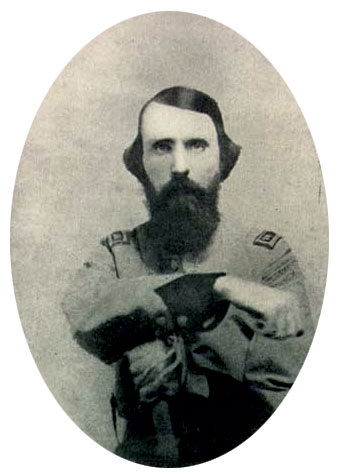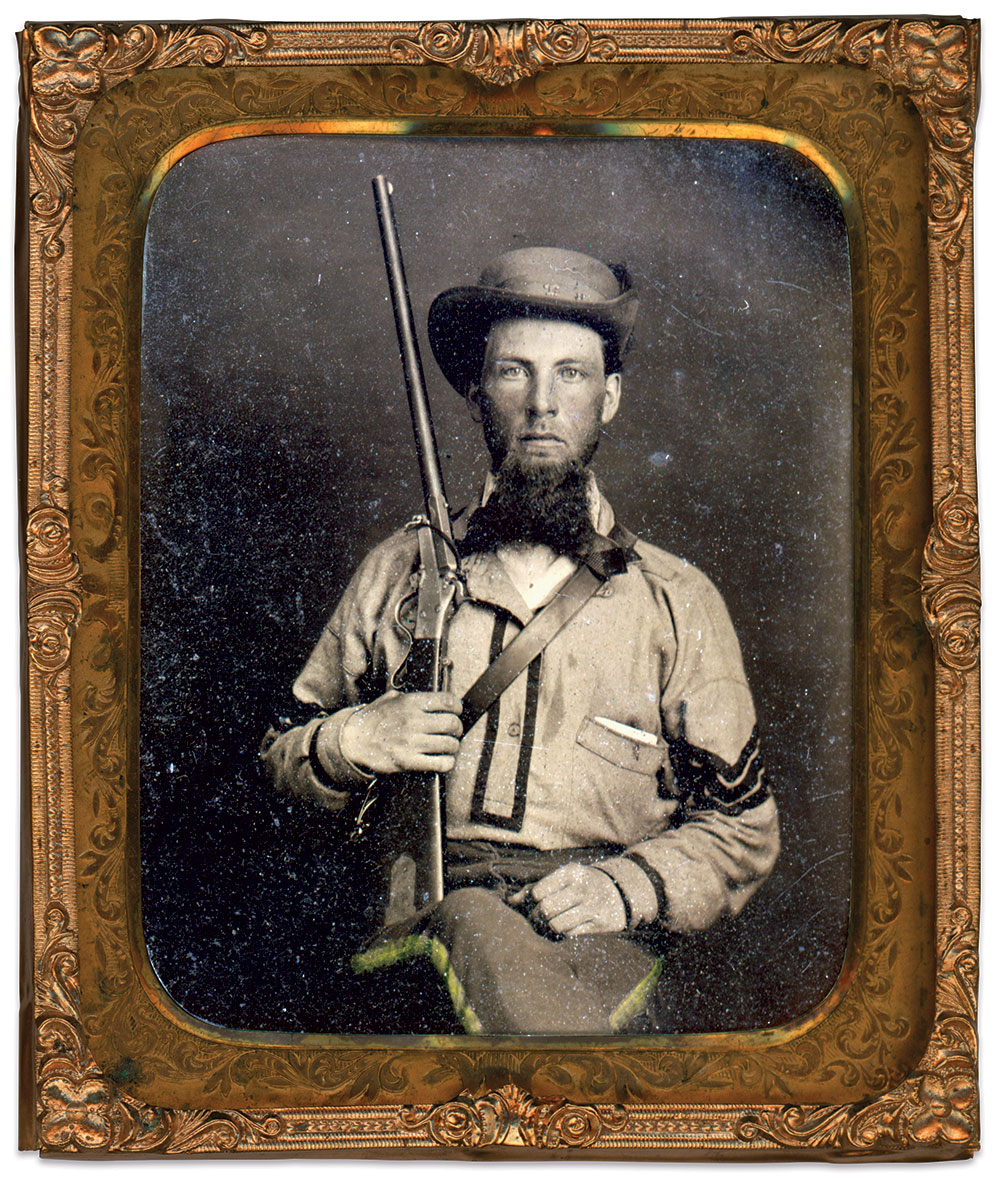By Phil Spaugy
The images of these early war, well-armed sergeants once resided in the Herb Peck collection, and have been reproduced in many publications over the last 60 years. They served in the Bolivar Troop, Company A, 1st Mississippi Cavalry Battalion. These men, their uniforms, the arms depicted in the images, and the early war actions of their unit, are the focus of this column.
The Bolivar Troop in 1861

The unit traces its origins to late 1860, when it formed in response to Abraham Lincoln’s victory in the presidential election. Its captain and founder, 30-year-old Frank Alexander Montgomery (1830-1903), owned the Bolivar County plantation Beaulah.
In January 1861, Montgomery traveled to New Orleans to equip his company with his own money. He purchased camp gear for his company and sabers and saddles for his officers—all the best he could find. His men furnished their own mounts, a custom in the Confederate cavalry.
The state of Mississippi purchased and issued Maynard carbines (often referred to in period accounts as a rifle), sabers and Model 1851 Colt Navy revolvers. There is little doubt that the Bolivar Troop was one of the best mounted and equipped cavalry companies in the Western Theater, if not the entire Confederacy, at the beginning of the war.
In May, the 100-strong company left its home county, steamed up the Mississippi River to Memphis, Tenn., and camped at the fairgrounds. Lacking saddles for their mounts they presented quite the appearance as they rode bareback through the city juggling arms and accoutrements. Here the Bolivar Troop became Company A of the 1st Mississippi Cavalry Battalion.
After two weeks of drill, the battalion spent the summer honing its skills in Tennessee, Missouri, and Kentucky. Life became a series of tedious drills, reviews for officers and civilians, and scouting missions.
The routine changed in September when the Bolivar Troop and another company, commanded by Capt. Montgomery, moved into Missouri to support an Arkansas infantry regiment and Watson’s Battery of Louisiana Artillery encamped near Belmont Landing.
Montgomery braced himself for his first enemy encounter. “I was anxious to come in contact with them, for I wanted to see how I would feel, and had some little anxiety as to whether I could stand fire with any degree of coolness,” he wrote in his 1901 Reminiscences of a Mississippian in Peace and War.
Montgomery’s wait ended on October 15. He and a detachment of 32 troopers from his company escorted a portion of the 13th Arkansas Infantry from Camp Johnson at the Mississippi River landing at Belmont to Underwood’s Farm, where forage had been abandoned by federals stationed at the nearby garrison of Birds Point. Overall command of the expedition fell to Lt. Col. Adam D. Grayson.

The Confederates successfully captured the forage, loaded it into wagons, and started on its return trip. Montgomery and his troopers continued to scout the area. As they rode ever closer to Birds Point, Montgomery spotted horse tracks along a road and detached an advance party of eight to investigate. In short order the advance scrambled back, pursued by about 50 Union cavalrymen belonging to Centralia Troop (Company H) of the 1st Illinois Cavalry, commanded by 1st Lt. Samuel P. Tufts.
Montgomery watched the enemy charge at a full gallop upon his position. He later observed “that he didn’t ever saw a prettier sight” as they approached. Montgomery held his men in check until the federals rode within 200 yards before he ordered them to fire their Maynards.
Montgomery was surprised that he did not see more federal saddles emptied after the opening volley. Tufts shook his men out from column into line and returned fire with their Sharps and Burnside carbines. Thus began a sharp, spirited, and short skirmish that ended when the Illinoisans fell back towards Birds Point.
Montgomery, not knowing if there were more federals lying in support close by, chose not to pursue. He later recalled the action as “the liveliest fusillade which had ever, up to that time been heard in that part of the country!”
Casualties were minimal. Tufts reported several troopers wounded, one mortally, and four horses killed and seven wounded. Montgomery reported one trooper wounded, three horses killed and several slightly wounded.
The mortally wounded federal, Cpl. Henry H. Fletcher, suffered a gunshot in the head and was left on the field. Montgomery declared Fletcher “the first man killed in the first open fight while the armies lay opposing each other between Columbus, Kentucky, and Cairo Illinois.” Montgomery retrieved Fletcher’s Colt revolver, Burnside carbine (which he later described as a better arm than his) and saber. Montgomery presented the trophies to two friends who had accompanied the Bolivar Troop on this mission.
Fletcher’s burial place is unknown. A marker, perhaps a cenotaph, is located in the Smith-Green Cemetery, near the village of Chateauguay, N.Y., not far from the border of his native Vermont and more than 1,000 miles from the place where he fell in defense of the Constitution.
A few weeks after the Birds Point skirmish, little-known Union Brig. Gen. Ulysses S. Grant led 3,000 men to victory against 5,000 Confederates commanded by Gen. Leonidas Polk at the Battle of Belmont.
Bolivar Troop and its battalion became part of the 1st Mississippi Cavalry regiment in early 1862 and served through the rest of the war.
The Images
Taken by an unknown photographer in early 1861, the portraits picture the first (or orderly) sergeant and one of the other five sergeants on the company roster of in Capt. Montgomery’s memoirs.
The orderly sergeant holds his .50 caliber Maynard carbine with its leather sling across his shoulder. The sling is attached to an elongated bar on the lower frame of the carbine. The front of his hat has the letters “BT” that stand for the “Bolivar Troop.” His gray hat has a black ostrich plume affixed to the side. His overshirt would be light blue gray with black facings and chevrons. The trousers appear to be gray with the tops of his knee-high cavalry boots barely discernible.

Based on Montgomery’s records, the man is Samuel Houston Starke (about 1839-unknown). One of his eyes is half closed and the pupil is light colored, which may be the result of a pre-war accident or a movement during the exposure of the photographic plate.
The sergeant is similarly armed and uniformed. There are, however, several differences.

The trousers are a darker shade, perhaps light blue with the yellow stripe of the cavalry branch. His overshirt has a breast pocket with what might be a notebook of some kind. While the black trim on his overshirt is the same, there is trim around the upper cuff on the sleeves.
Visible on his Maynard carbine is a small cap or patch box on the heel of the stock. This box held a couple of rolls on the unique Maynard tape primers, which provided the ignition for the carbine. (Ignition could also be provided by use of the conventional percussion cap being placed on the cone.) Also evident is the unique rear peep ladder sight which is folded down and partially hidden by his hand. The carbine also has a small nonadjustable rear sight on the barrel.
The leather thong that stretches from the barrel pivot pin to the chamber is also visible. This is thought to have been attached to the rim of the brass Maynard cartridge case so that, if needed, the carbine could be loaded from the muzzle. This attachment would ensure the case would not be lost and the carbine could be reloaded.
The “Mississippi” Maynard Carbine
Edward Maynard (1813-1891), a dentist-turned-arms innovator, invented and patented the carbine that bears his name in the early 1850’s.
The Model One Maynard rifle and carbine fared very well in the 1856 and 1857 U.S. Ordnance Department field tests. Equipped with another one of Maynard’s inventions, the revolutionary Maynard tape primer system, the firearm proved simple to operate and maintain, with a very acceptable degree of accuracy. In late December 1857, the Ordnance Department ordered 400 carbines. It took little time from this acceptance of the order for local media to take favorable notice of this new breechloading firearm.

During the six months following Lincoln’s election in November 1860 and the beginning of hostilities, the Maynard Rifle Company sold 3,201 carbines and rifles, with over 90 percent being purchased by Southern states and militia units primarily in Georgia, Florida, and Mississippi.
In late December 1860, the U.S Senators from Mississippi, Jefferson Davis and Jacob Thompson, contracted with the Maynard Arms company for 800 Maynard carbines (20-inch barrels) and rifles (26-inch barrels) and appendages. The first 500 were .50 caliber and the remaining 300 were .36 caliber. The cost of the contract was $27, 998.50.
The government issued Bolivar Troop 100 of the .50 caliber, 20-inch barrel carbines between March and June 1861, which may have been about the time these portraits were taken.
References: Montgomery, Reminiscences of a Mississippian in Peace and War; Official Records of the War of the Rebellion, Series I, Volume 3; McAulay, Civil War Carbines Volume II; Todd, American Military Equipage 1851-1872, Volume II; Troiani, Regiments and Uniforms of the Civil War; Madaus, American Society of Arms Collectors Bulletin #52; Newspapers.com; Fold3, Historical Data Systems.
Phil Spaugy is a longtime member of the North South Skirmish Association (N-SSA). He studies arms and accouterments of federal infantry soldiers with an emphasis on his home state of Ohio, firearms of the U.S. Arsenal at Harpers Ferry, and the Iron Brigade. He is a partner with Jim Hessler, in Hessler Spaugy Action Travel. Phil is a retired aviation services company executive who lives in Vandalia, Ohio, with his wife, Amy. He is a MI Senior Editor. Contact Phil at pspaugy@aol.com.
SPREAD THE WORD: We encourage you to share this story on social media and elsewhere to educate and raise awareness. If you wish to use any image on this page for another purpose, please request permission.
LEARN MORE about Military Images, America’s only magazine dedicated to showcasing, interpreting and preserving Civil War portrait photography.
VISIT OUR STORE to subscribe, renew a subscription, and more.

